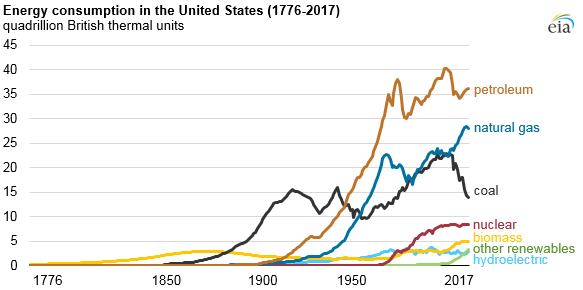New EIA report tracks U.S. energy use looking back to July 4, 1776
There are some government agencies you’ve just gotta love. The EIA is one of them. A newly published dataset tells why.
On the eve of the U.S.A.’s Independence Day celebration, the EIA published an overall history of energy in the U.S. from 1776 through today.
The founding fathers lived in an era that was very different from today, and their use of energy was no exception. Wood was the only fuel consumed in 1776, albeit at rates that are miniscule by today’s standards.
242 years ago: wood was the fuel of choice
The EIA estimates the U.S. consumed 250 trillion BTU that year, compared to 98,000 trillion BTU in 2017. For scale, 250 trillion BTU in a year is comparable to consuming 660 MMcf/d of gas, or 120 MBOPD.
American energy consumption gradually rose from 1776 through 1850, as the country’s population, and the country itself, grew.
The advent of coal, birth of industrialization
The first major shift came around 1850, when coal consumption began in earnest. Coal fueled the industrialization of the U.S., and it surpassed wood as the country’s largest source of energy around 1885. Coal demand in the early 1900’s was considerable, and the U.S. consumed more coal in the 1920s and 1950s than it did in 2017.
While coal fueled the first energy revolution in the U.S., oil and natural gas were close behind. The U.S. began consuming oil in 1860, when the first pioneers began drilling wells in Pennsylvania. Oil consumption did not grow nearly as rapidly as coal, however, and it took about 45 years for the U.S. oil industry to become a major business. Discoveries of plays like Spindletop in East Texas in 1901 revealed massive volumes of oil, and the rise of the automobile meant oil demand was considerable.
Next up: NatGas
Natural gas consumption followed a similar pattern. Gas consumption began in the mid 1880’s, but grew gradually for the first 45 years. The introduction of high pressure pipelines in the early 1900’s made gas much more viable on a national level, and consumption quickly took off.
Hydroelectric, nuclear, solar and wind energy have each been added to the country’s energy mix since then, but none has matched the consumption of oil, gas and coal.
Wood is a surprisingly popular energy source in the USA – for industrial customers
While wood power has been utterly surpassed by coal, gas and oil, consumers have not abandoned the oldest fuel, and wood power is surprisingly popular.
The EIA reports the U.S. consumed 2,145 trillion BTU of wood energy in 2017, comparable to the level consumed in 1850, when wood was essentially the only energy source available.
Most of this energy is used by industrial consumers, particularly wood and paper plants. The wood and paper industry commonly burns waste wood to produce steam and electricity, as this saves money that would otherwise be spent on fuel. Coal-burning power plants also can consume wood chips to reduce sulfur emissions.
Second most popular renewable energy source in the U.S. all the way till 2017: wood
Wood power was, in fact, the second most popular renewable energy source until very recently.
Wind energy in the U.S., which has attracted so much attention in recent years, only surpassed wood energy in 2017. Solar power is still far below wood power, with only 775 trillion BTU consumed in 2017, or only 36% of wood consumption.



